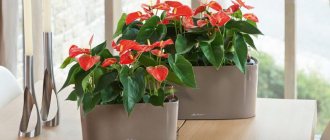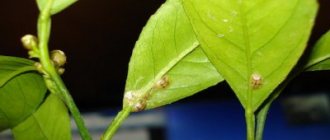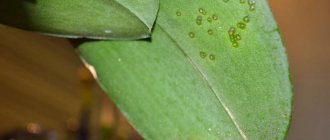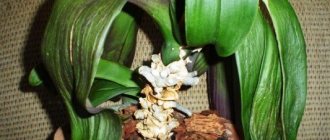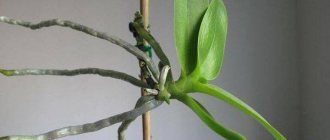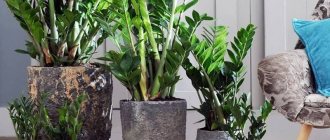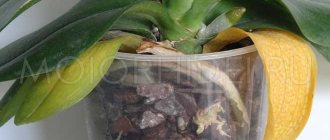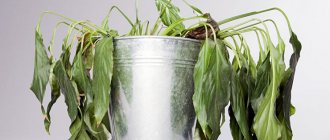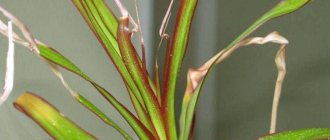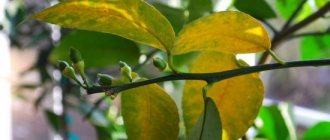So, at home, a cheflera may turn yellow and shed its leaves for the following reasons:
- air temperature is too low;
- waterlogging;
- incorrectly selected pot;
- damage to roots during transplantation;
- low lighting;
- illness;
- pest damage;
- adaptation;
- dry air;
- malnutrition;
Next, we will consider all the listed reasons in more detail, find out why they arise, and how to deal with the problem that has arisen in each specific case.
Diseases
Why does Schefflera shed its leaves?
There are several reasons why an umbrella tree might do this:
- Hypothermia. Schefflera loves coolness, but not drafts and cold (below 13 degrees). If the leaves fall but the trunk is still alive, you can save the flower. To do this, you need to place it in a warmer place, protected from drafts;
- Overheat. The plant is light-loving, but has a negative attitude towards direct sunlight;
It is necessary to change its location to a more comfortable one. In hot weather, spray 2 times a day.
- Low air humidity. In the autumn-winter period, you should keep the plant away from radiators, otherwise leaf fall is inevitable;
- Excessive waterlogging. The frequency of watering the shefflera depends on its place of residence. If it is on the sunny side, the soil dries faster and watering should be done more often with well-settled water. If the flower is in the shade, you should not overwater it, as this can lead to rotting of the root system and falling leaves. In this case, it is necessary to replant it, after removing the rotten part of the roots. Before planting in another container, the root system should be treated with a fungicide or root;
- Lack of light;
- Sudden change of location. Schefflera loves constancy and does not tolerate sudden movements. This is stressful for her and one of the reasons for shedding leaves. It is better to immediately choose the most comfortable place for the “umbrella tree” and not bother it with moving in the future;
- Dense soil and lack of drainage can also cause sudden leaf fall. The soil should be changed to a looser one. Place expanded clay drainage at the bottom of the pot.
They fall off and turn black
Leaves fall for the following reasons:
- Overflow. The plant should not be flooded; excess moisture can cause rotting of the root system and, as a result, blackening and falling off. Watering is necessary when the top layer of the substrate is dry. If there is water left in the tray of the pot after watering, it needs to be drained. If the root system is damaged by rot, shefflera can only be saved by replanting;
- Cold. If you water the shefflera with cold water in a draft or in a cold room, it can catch a cold and get sick. The leaves will begin to turn black and fall off. Watering should be done with well-settled water and the plant should change its place of residence to a more comfortable one;
- Sunburn. As a result of an excess of sunlight, the leaves darken and fall off.
Brown spots
In Schefflera, brown spots on the leaves appear for the following reasons:
- Excessive waterlogging or insufficient watering. Watering the plant should be moderate; you should not allow either waterlogging or drying out of the soil (the appearance of drying cracks on the soil surface);
- Pest damage (scale insects). Scale insect disease also causes the flower's leaves to turn brown and fall off.
Turn yellow and fall off
The Schefflera flower loses its leaves as a result of the natural process of yellowing and dropping of the lower leaves of the adult plant.
This is fine. This disease is associated, first of all, with a violation of the rules of maintenance. If you notice any signs of ill health, then it is necessary to eliminate the problem of care.
Thus, the cause of the fall may be:
- Overmoistening of the soil. It is necessary to reduce watering;
- Lack of nutrition. In this case, the plant should be fed with nitrogen fertilizers (bird droppings);
- Lack of light;
- Drafts.
- Pest infestation. In this case we are talking about mealybugs and spider mites;
The ends are drying out
- Dry air . It is necessary to spray 2 times a day, especially in the summer. In winter, the frequency of spraying is reduced, the plant is placed away from central heating radiators. Spraying helps temporarily. In hot weather, it is advisable to place the plant on a tray with wet expanded clay;
- Drafts can also cause leaf edges to dry out.
Why isn't Schefflera growing?
- Lack of fertilizers. The plant needs feeding;
- Transfer. For healthy growth and the appearance of large Schefflere leaves, replanting is necessary every 2 years.
Main Possible Causes
There are many reasons for Schefflera leaves to fall off. Therefore, when it begins to lose leaves, it can be difficult to determine the cause. Here are the main reasons why Schefflera leaves fall:
- Incorrect watering regime;
- Temperature too low or high;
- Unsuitable air humidity for the plant.
There are other reasons:
- Excess feeding;
- Incorrect lighting;
- Presence of pests.
The temperature regime is also very important for the plant. Thus, a low temperature in combination with abundant watering very quickly causes stagnation of water and the development of putrefactive bacteria. And this is reflected in the condition of the flower, which, as it rots, begins to lose its leaf blades.
The falling of plant leaves is most often affected by insufficient humidity. Dry air causes leaves to dry out and fall off. High humidity can cause leaf fall only in combination with abundant watering. This growing regime promotes rotting of flower tissues.
Other reasons lead to loss of leaves extremely rarely and only in case of gross violation of the rules of care. If the plant is fed too intensively or placed in direct sun, if pests infest it, then it will most likely not be possible to preserve its foliage.
Care errors
Most often, the owners are to blame for the Schefflera's leaves turning yellow and falling off. Moreover, the crop often suffers not because of inattention, but because flower growers do not understand that care needs to be adjusted depending on external factors.
Improper watering
Schefflera is very sensitive to waterlogging of the soil. With a good substrate, a single mistake is unlikely to cause leaves to fall, but if watering is not controlled, you can lose the plant.
The young upper plates are the first to react to trouble - brown spots appear on them. When the lower ones turn brown and begin to fall off, it means that the root is already rotting.
At this stage, the Schefflera can still be saved; the affected shoots should be cleaned and the substrate should be completely changed. If the trunk of the plant is covered with spots, you urgently need to root the top.
Parasites
Why else do schefflera leaves fall? This can occur under the influence of pests. True, this phenomenon occurs only when the parasites on the plant have proliferated too much. At the beginning of their appearance, nothing like this happens. Schefflera can be affected by spider mites, scale insects and aphids. They feed on plant sap and are almost impossible to notice right away.
The mite can be detected only when a thin web appears, and the aphid reveals itself by the appearance of white spots on the lower surface of the leaves. You can get rid of them with a simple soap solution and then rinsing the plant. Additionally, treat the stems and leaves with insecticides.
Parasites will never disappear from the plant by themselves. If you do not provide help, the cheflera will die.
If you take proper care of the shefflera, then no darkening of the leaves and, especially, their falling off will not occur. In addition, with proper care, parasites never appear on this plant.
Olga Danilina
Pests to which the flower is susceptible
The most dangerous to plants are pests. They are capable of infecting both the leaves and stem of the flower, as well as the root system at home.
Often indoor plants, including sheflera, suffer from pests such as spider mites, aphids and scale insects . You can fight them by spraying them with a soapy solution.
It is advisable to carry out such prevention once a week. If the plant is already affected by the pest, spraying is done every day or several times a day.
If spraying does not help , it is necessary to use special preparations to control pests. Such products are sold at any flower shop.
The drug "Karbofos" helps well in the fight against flower pests. When treating with such a drug, it is advisable to take the affected specimen outside or onto a balcony, as it has a very unpleasant odor.
Photo
The photo shows Schefflera with proper care at home:
Those who grow Schefflera may find useful articles about caring for the plant, as well as methods of propagation.
Improper care or conditions
Most often, the sudden falling of flower leaves is associated with improper care or unsuitable microclimate conditions in the room. In this case, you need to carefully analyze all the external factors affecting the shefflera and find the reason for the fall of the green mass. Only after this can concrete actions be taken to eliminate the problem.
Poor lighting or direct sunlight
For normal growth, Schefflera needs bright, diffused light. With a lack of lighting, the leaves of the flower begin to wither and turn yellow, and then fall off. In direct sunlight, the flower may develop sunburn.
If the cause of the falling is improper lighting, then you can solve the problem using the following actions:
- if possible, place the pot with the plant near the eastern or western windows - in such a place the sheffler will receive a sufficient amount of light, but will not be exposed to direct sunlight;
- in rooms with southern windows, place the flower at a short distance from the window so that direct rays of the sun do not reach it;
- in darkened rooms, as well as during short daylight hours, use artificial lighting.
Failure to comply with the watering regime
This fact is the most common reason why Schefflera leaves fall off.
As a result of improper watering, phenomena such as:
- rotting of the roots of a flower with a significant excess of moisture in the soil, especially in a cold room;
- drying out of the earthen coma and death of the root system due to lack of water.
At the initial stage, it is easy to fix this problem. To do this, it is enough to adjust the watering regime and trim those leaves of the flower that are completely dry.
But if the Schefflera root system is also damaged, then more serious actions need to be taken:
- Remove the plant from the old pot and carefully examine all its roots.
- Cut off rotten, damaged and dead roots.
- Place the Schefflera roots in a solution of fungicide or Epin for a couple of hours.
- Replant the flower in fresh soil.
- Treat the ground part of the shefflera with Epin and cover it with a bag for 2-3 days.
- Adjust the plant’s watering regime, adding water only after the top layer of soil has dried.
Sudden changes in temperature
Schefflera does not tolerate heat and cold in the room. If the falling of the leaves of a flower was preceded by its prolonged exposure to a hot or cold room, then the cause of the problem lies in the incorrect temperature conditions. Schefflera also reacts negatively to sudden temperature changes.
Actions to save the plant should begin immediately after the first signs of shedding the green mass were noticed. If you leave this problem unattended, then the trunk of the flower will begin to dry out along with the leaves. In this case, it will no longer be possible to save the sheffler.
To fix the problem, you need to do the following:
- Carefully trim off all dry leaves and branches.
- Cauterize the cut areas with powdered activated carbon.
- Dig the Schefflera out of the old pot along with a lump of earth and replant it in new soil.
- Place the flower in a warm room with a temperature of +17. +22 °C. Avoid temperature changes.
Drafts
Schefflera needs fresh air, so the room with the plant needs regular ventilation. But if the flower stands in a draft, the leaves will not fall off. Within a day after the shefflera is constantly at the intersection of air flows, the tips of its leaves will begin to dry out.
To prevent the foliage of a flower from falling, you need to do the following:
- Trim off any yellowed leaves.
- Remove the pot with shefflera from the draft.
- In the warm season, cover the flower with a thick cloth while airing.
- Move the plant to another room for ventilation if the air temperature outside is much lower than indoors.
Dry indoor air
Sometimes the cause of plant leaves falling off is too dry air in the room. If Schefflera is grown in a stuffy room with low humidity and dust collects on its leaves, they may begin to turn yellow and fall off.
To help the plant and stop its leaves from falling, you need to maintain a higher than average humidity level in the room.
This can be achieved using the following actions:
- Spray the flower leaves with water daily and periodically wipe them from dust with a damp sponge.
- Place the pot with the plant near the aquarium or on a tray with wet expanded clay.
- Use automatic humidifiers.
Excess of mineral fertilizers
For normal growth, Schefflera needs regular feeding, but excess mineral fertilizers can lead to burns to the roots of the flower. As a result, the leaves of the plant turn yellow and fall off, and if measures are not taken in time, burns to the roots can lead to the death of the shefflera.
Bacteria
Darkening and falling of leaves can occur due to the presence of fungal or pathogenic bacteria in the soil. They may appear there if, when transplanting the cheflera, you were too lazy to treat the soil with a weak solution of manganese. If you find that the leaves have begun to turn yellow, try treating the soil with a fungicide.
If this simple procedure turns out to be ineffective, then replant the plant in new soil, which you prepare according to all the rules.
Home care
Tropical Schefflera loves sunlight. In autumn and winter, the plant feels good on the south side of the house, and if the sun is not enough for it, it will require additional illumination with a phytolamp. In the summer months, the flower should be protected from direct sunlight and, if possible, shaded. A good place for a flower can be the western and eastern sides of the house. If your apartment does not have conditions for good lighting of the plant, it is best not to have variegated types, but to purchase a regular green variety.
Caring for shefflera is not difficult - it loves high humidity, but if this is not possible, you can limit yourself to frequent spraying of its leaves. In room conditions, a comfortable temperature for a plant is considered to be between 12 and 18 degrees Celsius. The plant reacts poorly to proximity to heating devices and does not like drafts.
Water the flower with settled soft water and do this as the top layer of soil dries. In winter, the frequency of watering is reduced, but the soil in the pot should not be allowed to dry out. Excessive moisture stagnant near the roots is detrimental to the plant.
Fertilizing is introduced in the spring-summer period with a frequency of 2 times a month.
Non-compliance with temperature conditions and solution to the problem
Schefflera does not like temperatures that are too high or too low. The ideal temperature for keeping it is 20-22ºС. It is not recommended to lower the temperature below 17ºС, as the plant will not feel well. And with a further decrease, the shefflera will begin to shed its leaves. Also, at low temperatures, there is a possibility of plant roots rotting, which also very quickly affects its appearance.
Often the flower falls off in a draft, especially in a cold one. Such a sharp change in temperature is unusual for shefflera, which reacts to it with intense leaf fall.
The plant can hardly tolerate summer heat. Temperatures above 25ºС are also unacceptable for him. It can tolerate a slight increase in temperature only if there is abundant watering and increased air humidity.
How to provide the plant with an acceptable temperature regime? In apartment conditions this is not difficult. In summer, you need to put the flower in the shade so that it does not overheat. In winter, shefflera feels great on a lit windowsill. You just need to remove it from heating appliances and from opening window sashes.
Why do leaves turn yellow, turn black, or wither before falling off?
Even before the Schefflera leaves begin to fall, you can identify errors in caring for the plant. You should not wait for the leaves to fall, as the flower will lose its beauty for a long time. Diagnosis is carried out according to the condition of the plant. Leaves before falling may:
- turn yellow;
- To darken or turn black;
- Fade.
Yellowing and falling of the lower leaves of Schefflera is a natural process. If there are only a few of these records, no need to worry. But massive yellowing indicates damage to the root system. This can happen as a result of the earthen clod drying out, which is extremely undesirable. Also, yellowing of the leaves occurs when the roots are burned by fertilizers.
Usually, if a maintenance error is detected and corrected at the very beginning, the plant will recover and grow new leaves, but the yellowed blades will fall off. But if the plant has already lost most of its green mass, its roots cannot be restored.
Sometimes yellowing of some part of the crown is observed. Most likely, this occurs due to direct sunlight hitting the leaves. At the same time, you need to choose more suitable lighting for the flower.
Schefflera leaves turn black or darken and fall off due to a fungal infection. When the soil is systematically waterlogged, the plantains darken. They may turn brown or even black. Then they fall off. In this case, only replanting into new soil will save the plant from death. All rotten roots and damaged leaves must be removed, and the remaining plant must be treated with antifungal drugs.
Wilting can be observed with a significant increase in temperature. It is urgently necessary to reduce it, otherwise the leaves will begin to dry out and die. Wilting is also observed in open sun. Subsequently, such leaves become covered with burns and dry out. Now you know what to do if Schefflera sheds its leaves.
Leaves fall off after transplanting
Yellowing of schefflera often occurs when moved to another pot. If it was a full-fledged transplant with exposed roots, the operation rarely goes without leaf fall. But owners also make mistakes.
Priming
The substrate for shefflera should be slightly acidic or neutral. The best solution is to buy a ready-made one, intended for ficus or ornamental deciduous crops. When preparing a soil mixture yourself, it is not always possible to fully disinfect the components or select them correctly. As a result, the shefflera turns yellow and drops its leaves.
Causes:
- alkaline reaction or too high acidity of the soil;
- soil pests - even earthworms that fall into a pot turn into them;
- dense substrate - the roots do not receive enough oxygen, the water stagnates, it is difficult to care for the shefflera;
- poor permeability of components.
Often the soil becomes salty from watering with hard water. The white crust on the surface can be removed. If plaque covers the walls of the pot, the soil will have to be changed.
Pot
The container for shefflera needs a regular shape and must contain holes for water drainage. Otherwise, the substrate will constantly become soaked.
With each transplant, the size is increased by 2-3 cm. A pot that is too large will not only cause a stunting of growth. The roots need to braid a ball. If there is a lot of free space, this will take considerable time; the plates of the shefflera will begin to turn yellow and fall off. Leaf fall will stop when the flower has covered all the soil.
A container that is too small and filled only with roots and soil residues does not hold water well; when fertilizing, the underground part often gets burned by fertilizers. The result is that the foliage turns yellow and falls off.
Transfer time
Any movement to a new container is associated with injuries to the sucking processes. Even transshipment. The root system regenerates in the same way as other parts of plant organisms. If the transplant is done at the end of the season, the process is slow, the foliage turns yellow and falls off, and when the injury affects the main roots, the shefflera may even die.
In the summer she has already spent a lot of effort on building up green mass. In addition, heat negatively affects the general condition of the flower; only it can cause leaf fall. Excessive injury will make the situation worse.
Transplants should be done at the beginning of the growing season.
Planting process
It is best for the sheffler to pass without destroying the earthen clod. This way the roots are minimally damaged, and the suspension of growth processes often goes unnoticed.
The more damaged the underground part is, the more time it takes to recover. The Schefflera root system spends energy on regeneration, and is not able to feed all the vegetative organs; some of them turn yellow and fall off.
Tags
The shefflera's leaves are falling off. The shefflera's leaves are falling off. If the shefflera's leaves are falling off, the shefflera's leaves are turning yellow. Leaves fall Shefflera leaves of natural leaf fall leaves usually fall Leaf plates darken Leaves dry up All leaves fall foliage leaves need care needs to be adjusted Flower needs less Leaves only need Roots need to be braided Transplants need to be done Time is needed for
colors
Causes of sheflera leaves falling off: effective methods of treating indoor plants
Every gardener tries to provide his plants with the best conditions and care. But sometimes, despite good conditions, the plants do not look healthy. Owners of indoor shefleras often complain that the plant's leaves fall off. There aren't many reasons why this happens.
articles
- 1 Causes of leaf falling
- 2 Pests and diseases
Causes of leaf falling
In almost all cases, the leaves of the sheflera fall off due to violation of the conditions of maintenance and care. But in order to help the plant and save it, it is necessary to identify the specific cause. And they may be as follows.
Presence of fungal or bacterial spores
In order for the plant to grow well, the soil must be disinfected before planting. There are several ways - calcine the soil in a hot oven, pour boiling water on it, or treat it with special preparations.
If fungal spores or pathogenic bacteria remain in the soil, this can cause the development of diseases of the root system. Then the plant begins to grow poorly, and the leaves may turn yellow and crumble.
When such a problem occurs, it is necessary to treat the soil with a fungicide.
Excess moisture
Violation of the watering regime is the most common cause of plant diseases. At the same time, the soil becomes swamped, and in conditions of room temperature, which are favorable, pathogenic microorganisms begin to develop. They cause root rot.
In too wet soil there is always insufficient oxygen, so the plant begins to suffocate and the leaves turn yellow or become covered with black spots.
There is only one way to combat this problem - by replanting into new soil. In this case, rotten leaves, shoots and roots must be removed. After pruning, the roots need to be dried and sprinkled with charcoal or cinnamon.
After transplanting, the shefflera is not watered for several days.
Lack of moisture
Insufficient water in the soil is not so detrimental to the plant, but it also harms it. First of all, the decorative appearance suffers. Such specimens are weakened and more susceptible to disease. Their leaves begin to lose turgor, wither and fall off.
Too dry air causes black spots to appear on the leaves. In addition, in such conditions, the risk of spider mites, which love dry air, increases. Therefore, you need to periodically spray the plant and follow the watering regime.
Top dressing
Excess of mineral fertilizers, and especially nitrogen, causes burns to the root system. It begins to function poorly, and the foliage turns yellow.
Lighting
Each plant has its own light requirements. Some people like darker places, while others are not afraid of the burning rays of the spring sun.
Sheflera belongs to the category of those that love well-lit places, but cannot tolerate exposure to sunlight. Direct rays can burn the flower and the leaves will become yellow and limp.
Lack of light does not cause such manifestations, but the pattern on the leaves will be practically invisible.
Temperature
The optimal temperature for sheflera is the range of +17-22 degrees. The plant does not tolerate increased temperatures well. The leaves lose turgor and begin to wither.
Reproduction methods
Cuttings
In the spring, semi-lignified cuttings are cut, rooted in a substrate or water, and left in a warm place. For good root formation, it is optimal to treat sections of cuttings with a stimulator.
The cutting, which took root in water, after the roots appear, is planted in a soil substrate, covered with a plastic bag with holes, which must be removed every day for 20-30 minutes for ventilation.
If the process of rooting the cuttings took place in the soil substrate, put the bag on immediately, removing it daily for ventilation. The soil mixture is watered moderately to avoid excessive moisture.
Seeds
Sowed in winter, possibly in March. The seeds are placed in the soil mixture to a depth of 0.5 cm, watered, covered with plastic film, and placed in a room with an air temperature of +22...+25 degrees. The container for sowing must have drainage and holes to remove excess moisture. The film is removed daily for ventilation.
After 30 days, shoots appear, then the container should be moved to a well-lit place with a temperature of +15...+17 degrees. When the weather becomes hot and dry, the seedlings are sprayed with water at room temperature.
Insufficient air humidity
Usually the air in a city apartment is not humid enough for growing shefflera. Its leaves often dry out and fall off, exposing the trunk. To prevent this from happening, it is advisable to increase the air humidity near the plant.
There are several ways to increase humidity. The simplest and most widespread is spraying. In hot weather or during the heating season, when the indoor air is especially dry, it is recommended to spray the plant 1-2 times a day. In cool weather, you can carry out this procedure 1-2 times a week.
Popular types
Tree-like
An evergreen shrub, in natural conditions it grows up to 4 m. The leaves are palmate, the width of the leaf blades is up to 10 cm, the length is up to 20 cm.
Gerda
Schefflera variegated Gerda
A representative of the Schefflera species is tree-like, its foliage is a bright yellow-green or white-green shade, similar to an open rosette. It reaches a height of 2.5 m and is unpretentious in care.
Compact appearance, leaf blades are divided and slightly rounded, dark green in color, undemanding to care for at home.
Janine
It is characterized by elegant foliage of a light olive hue with yellow splashes and a lush crown.
Bianca
It is distinguished by spectacular leaves that are covered with a pattern. The leaf blades reach 8 cm in length, they have a white edge at the edges, and a beige shade at the base.
Arboricola
The leaf blades are characterized by a white or golden-variegated hue. It reaches a height of 120 cm, branches well. There are green and variegated varieties. Mature plants need to be pruned.
Radifolia
Under natural conditions it grows up to 15 m, in domestic conditions - up to 2.5 m. The trunk of the plant is light brown, on red-brown petioles there are large and shiny leaf plates of a bright green shade up to 60 cm long.
Louisiana
Undemanding to care, leaf blades are decorative, variegated, openwork, leathery, shiny.
Melanie
The plant is unpretentious, the leaf plates are painted in various shades of green, the crown looks very elegant.
Description
Shefflera is native to Japan, China, East Asia, Taiwan, Australia, and Vietnam. In nature, it grows in tropical forests in regions with humid and hot climates.
This evergreen plant has glossy finger-shaped leaves of a dark green hue, which sit on long petioles. Shefflera's leaf blades diverge from one point, like the spokes of an umbrella, which is why it is called the “flower with green palms.”
Peculiarities
Schefflera belongs to the Araliaceae family and grows in the wild in Australia, Africa, South America and Asia. Shefflera leaves have a green or variegated color. The leaf is attached to the trunk by a long petiole, where the dissected parts of the leaf plate are located. Outwardly, it looks like an umbrella consisting of lobules, the number of which varies from 4 to 12, but they are all connected at one growth point. A growing shefflera stretches upward with its shoots; for stability, it is fixed on vertical supports or pruned, forcing it to branch.
How to save a shefflera. #3 MirLana
Sent
A photo would be nice. How tall are sheffleras? IMHO: During transplantation, the roots were injured, then they flooded. I dry mine on the knuckle of a finger in the summer and up to about 1/2 of a pot in the winter. She is much less afraid of drought than the flood. It’s better to spray one more time than to water it. And two meters from which window? Mine is located in the south-west with light shading - in partial shade it grew very slowly, accordingly: the less light, the easier it is to flood it. And one more thing: if it falls out of the ground, you risk losing the last roots. It must be fixed - tied to a support. Otherwise, new damage will occur. In a humid environment they can rot again. And be sure to sprinkle them with coal. What kind of soil is it sitting in? What type of shefflera? Green or variegated? The latter is more capricious. I would do this: If it is large, put the crown for rooting (it is better to treat the cut with heteroauxin or root and place it in a warm, bright place under a cap), the rest into the pot along the root. If it’s small, I wouldn’t risk cutting it. Place thick drainage (expanded clay, for example) on the bottom, then sprinkle it with crushed coal and loose soil. For Scheffler, I make approximately the following mixture: Vita Terra (or for dracaenas) + coarse sand + red brick (crushed smaller) + vermiculite + coal). Soak for a couple of hours in zircon, then a little (15 - 30 minutes) in phytosporin. Sprinkle the roots with coal and plant them firmly in place. Do not water the ground (there is enough moisture in the store), spray with zircon. When the leaves are dry, put under the bag, but only the tops. It is better to leave the ground open. The first watering is only after it has dried somewhere on the phalanx. It's better to just spray it well. It is normal to water only after new growth. New leaves will appear, which means the roots have already grown.
How tall are sheffleras? IMHO: During transplantation, the roots were injured, then they flooded. I dry mine on the knuckle of a finger in the summer and up to about 1/2 of a pot in the winter. She is much less afraid of drought than the flood. It’s better to spray one more time than to water it. And two meters from which window? Mine is located in the south-west with light shading - in partial shade it grew very slowly, accordingly: the less light, the easier it is to flood it. And one more thing: if it falls out of the ground, you risk losing the last roots. It must be fixed - tied to a support. Otherwise, new damage will occur. In a humid environment they can rot again. And be sure to sprinkle them with coal. What kind of soil is it sitting in? What type of shefflera? Green or variegated? The latter is more capricious. I would do this: If it is large, put the crown for rooting (it is better to treat the cut with heteroauxin or root and place it in a warm, bright place under a cap), the rest into the pot along the root. If it’s small, I wouldn’t risk cutting it. Place thick drainage (expanded clay, for example) on the bottom, then sprinkle it with crushed coal and loose soil. For Scheffler, I make approximately the following mixture: Vita Terra (or for dracaenas) + coarse sand + red brick (crushed smaller) + vermiculite + coal). Soak for a couple of hours in zircon, then a little (15 - 30 minutes) in phytosporin. Sprinkle the roots with coal and plant them firmly in place. Do not water the ground (there is enough moisture in the store), spray with zircon. When the leaves are dry, put under the bag, but only the tops. It is better to leave the ground open. The first watering is only after it has dried somewhere on the phalanx. It's better to just spray it well. It is normal to water only after new growth. New leaves will appear, which means the roots have already grown.
